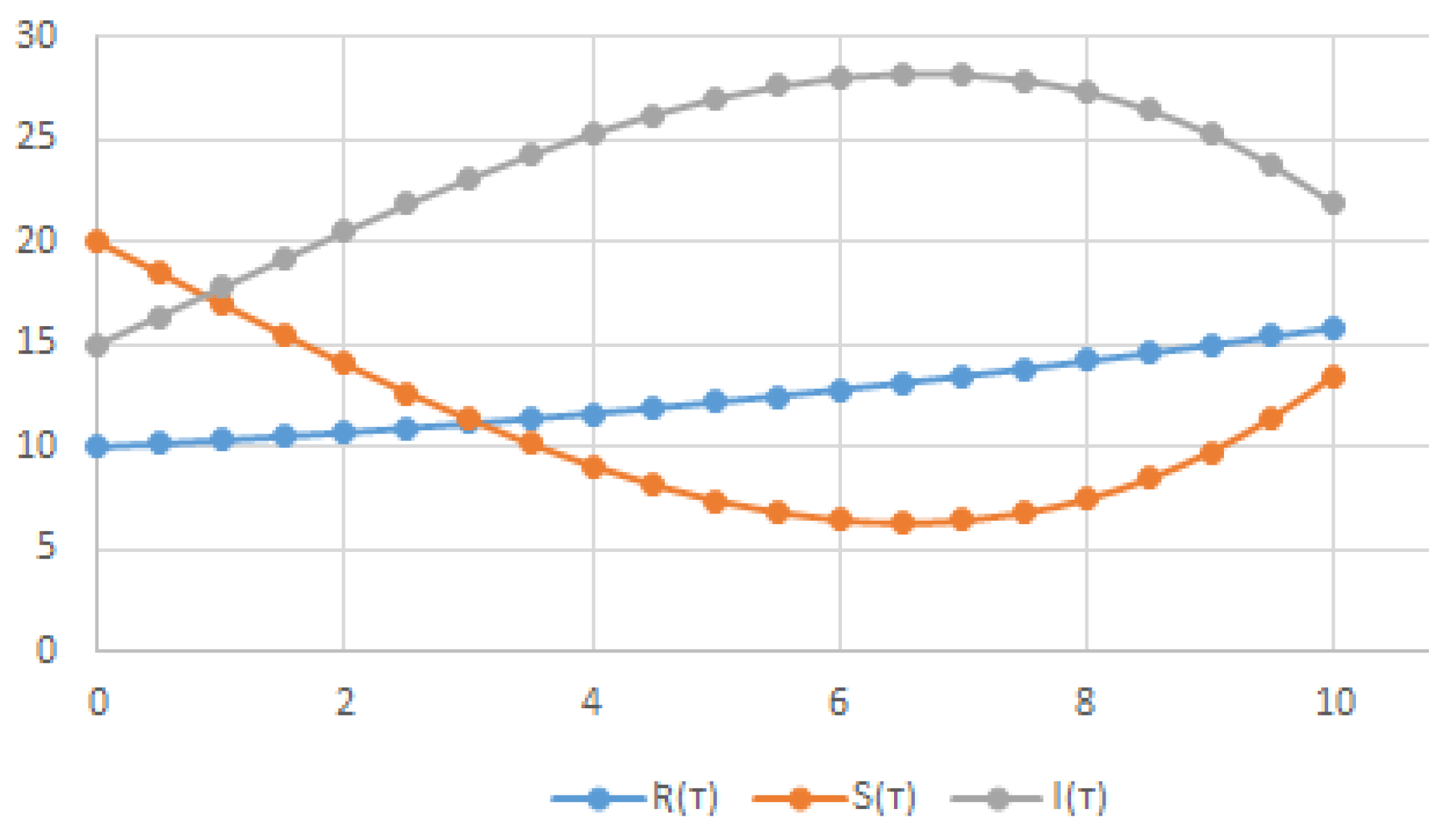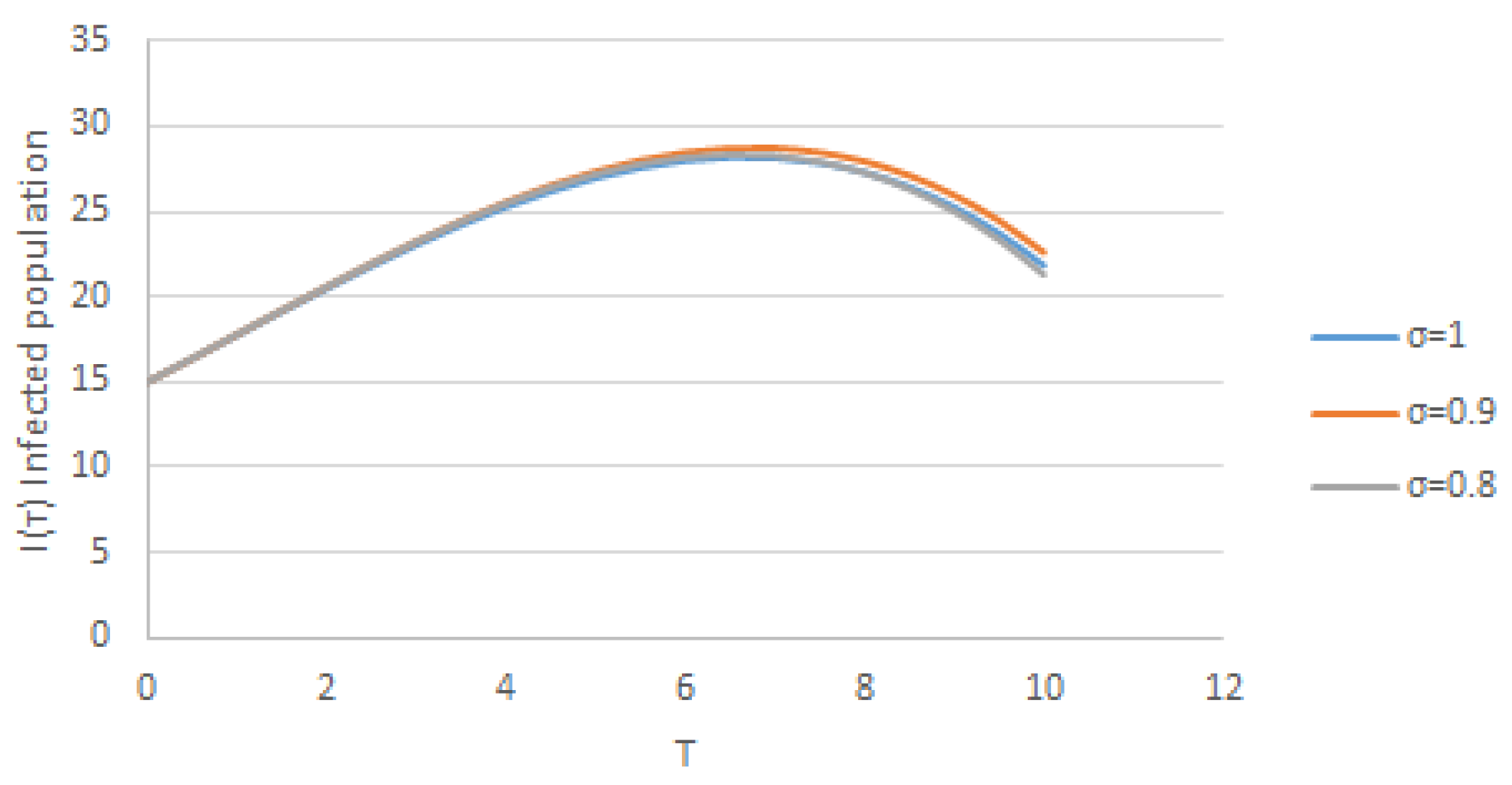An Efficient Approach to Solving the Fractional SIR Epidemic Model with the Atangana–Baleanu–Caputo Fractional Operator
Abstract
1. Introduction
2. Basic Definitions
2.1. Definitions and Properties of the ZZ Transform
2.1.1. Some Properties of the ZZ Transform
2.1.2. ZZ Transform of Several Elementary Functions
| ine 1 | 1 |
| ine ⊺ | |
| ine | , |
| ine |
3. Implementation of HPZZTM to the General Nonlinear Fractional Differential Equations
4. Study the Epidemic Model with Atangana–Baleanu–Caputo Fractional Derivative
4.1. Presentation of the Problem
4.2. The Existence of the Solution
4.3. The Solution by Applying This Approach
5. Numerical Results and Discussion
6. Conclusions
Author Contributions
Funding
Data Availability Statement
Conflicts of Interest
References
- Ray, S.S.; Atangana, A.; Noutchie, S.C.O.; Kurulay, M.; Bildik, N.; Kilicman, A. Fractional Calculus and Its Applications in Applied Mathematics and Other Sciences. Math. Probl. Eng. 2014, 2014, 849395. [Google Scholar] [CrossRef]
- Jacob, J.S.; Priya, J.H.; Karthika, A. Applications of fractional calculus in science and engineering. J. Crit. Rev. 2020, 7, 4385–4394. [Google Scholar]
- Fellah, Z.E.A.; Fellah, M.; Ongwen, N.O.; Ogam, E.; Depollier, C. Acoustics of Fractal Porous Material and Fractional Calculus. Mathematics 2021, 9, 1774. [Google Scholar] [CrossRef]
- Siddique, I.; Mirza, A.M.; Shahzadi, K.; Akbar, M.A.; Jarad, F. Diverse Precise Traveling Wave Solutions Possessing Beta Derivative of the Fractional Differential Equations Arising in Mathematical Physics. J. Funct. Spaces 2022, 2022, 5613708. [Google Scholar] [CrossRef]
- Nadeem, M.; Wahash, H.A. Analysis of Fractional Kundu-Eckhaus and Massive Thirring Equations Using a Hybridization Scheme. J. Funct. Spaces 2023, 2023, 6704537. [Google Scholar] [CrossRef]
- He, J.H. Fractal calculus and its geometrical explanation. Results Phys. 2018, 10, 272–276. [Google Scholar] [CrossRef]
- Baleanu, D.; Mohammadi, H.; Rezapour, S. A fractional differential equation model for the COVID-19 transmission by using the Caputo-Fabrizio derivative. Adv. Differ. Equ. 2020, 2020, 299. [Google Scholar] [CrossRef]
- Amara, A.; Etemad, S.; Rezapour, S. Approximate solutions for a fractional hy-brid initial value problem via the Caputo conformable derivative. Adv. Differ. Equ. 2020, 2020, 608. [Google Scholar] [CrossRef]
- Shah, N.A.; Alyousef, H.A.; El-Tantawy, S.A.; Shah, R.; Chung, J.D. Analytical investigation of fractional-order Korteweg-De-Vries-Type equations under Atan-gana-Baleanu-Caputo operator: Modeling nonlinear waves in a plasma and fluid. Symmetry 2022, 14, 739. [Google Scholar] [CrossRef]
- He, J.H.; Li, Z.B.; Wang, Q.L. A new fractional derivative and its application to explanation of polar bear hairs. J. King Saud Univ. Sci. 2016, 28, 190–192. [Google Scholar] [CrossRef]
- He, J.H.; Elagan, S.K.; Li, Z.B. Geometrical explanation of the fractional complex transform and derivative chain rule for fractional calculus. Phys. Lett. A 2012, 376, 257–259. [Google Scholar] [CrossRef]
- MAl-Refai, M.; Baleanu, D. On an extension of the operator with Mittag-Leffler kernel. Fractals 2021, 12, 22401296. [Google Scholar]
- Atangana, A.; Baleanu, D. New fractional derivatives with nonlocal and non singular kernel: Theory and application to heat transfer model. Ther. Sci. 2016, 20, 763–769. [Google Scholar] [CrossRef]
- Catas, A.; Lupas, A.A. Some Subordination Results for Atangana–Baleanu Frac-tional Integral Operator Involving Bessel Functions. Symmetry 2022, 14, 358. [Google Scholar] [CrossRef]
- Alqahtani, R.T. Atangana–Baleanu derivative with fractional order applied to the model of groundwater within an unconfined aquifer. J. Nonlinear Sci. Appl. 2016, 9, 3647–3654. [Google Scholar] [CrossRef]
- Syam, M.I.; Al-Refai, M. Fractional differential equations with Atangana–Baleanu fractional derivative: Analysis and applications. Chaos Solitons Fractals X 2 2019, 2, 100013. [Google Scholar] [CrossRef]
- Lupas, A.A.; Catas, A. Applications of the Atangana–Baleanu Fractional Integral Operator. Symmetry 2022, 14, 630. [Google Scholar] [CrossRef]
- Lupas, A.A.; Catas, A. Properties of a Subclass of Analytic Functions Defined by Using an Atangana–Baleanu Fractional Integral Operator. Symmetry 2022, 14, 649. [Google Scholar] [CrossRef]
- Chikh, S.B.; Amara, A.; Etemad, S.; Rezapour, S. On Hyers-Ulam stability of a multi-order boundary value problems via Riemann-Liouville derivatives and integrals. Adv. Differ. Equ. 2020, 2020, 547. [Google Scholar] [CrossRef]
- Rezapour, S.; Imran, A.; Hussain, A.; Martinez, F.; Etemad, S.; Kaabar, M.K.A. Condensing Functions and Approximate Endpoint Criterion for the Existence Analysis of Quantum Integro-Difference FBVPs. Symmetry 2021, 13, 469. [Google Scholar] [CrossRef]
- Mukhtar, M.; Yaqoob, M.; Samraiz, M.; Shabbir, I.; Etemad, S.; De la Sen, M.; Re-zapour, S. Novel Mean-Type Inequalities via Generalized Riemann-Type Fractional Integral for Composite Convex Functions: Some Special Examples. Symmetry 2023, 15, 479. [Google Scholar] [CrossRef]
- He, J.H. A coupling method of homotopy technique and perturbation technique for nonlinear problems. Int. J. Non-Linear Mech. 2000, 35, 37–43. [Google Scholar] [CrossRef]
- He, J.H. Homotopy perturbation technique. Comput. Meth. Appl. Mech. Eng. 1999, 178, 257–262. [Google Scholar] [CrossRef]
- Zafar, Z.U.A. Application of ZZ Transform Method on Some Fractional Differential Equations. Int. J. Adv. Eng. Glob. Technol. 2016, 4, 1355–1363. [Google Scholar]
- Zafar, Z.U.A. ZZ Transform Method. Int. J. Adv. Eng. Glob. Technol. 2016, 4, 1605–1611. [Google Scholar]
- Areshi, M.; Naeem, M.; Wyal, N. Analytical Investigation of Some Dy-namical Systems by ZZ Transform with Mittag-Leffler Kernel. Complexity 2022, 2022, 7635696. [Google Scholar] [CrossRef]
- Gihan, E.H.A.; Asaad, A.A.; Elagan, S.K.; Mawaheb, E.-A.; AlDien, M.S. Using Laplace transform method for obtaining the exact analytic solutions of some ordinary fractional differential equations. Glob. J. Pure Appl. Math. 2017, 13, 5021–5035. [Google Scholar]
- Watugala, G.K. Sumudu transform: A new integral transform to solve differen-tial equations and control engineering problems. Int. J. Math. Educ. Sci. Technol. 1993, 24, 35–43. [Google Scholar] [CrossRef]
- Maitama, S.; Zhao, W. New Integral Transform: Shehu Transform a Generaliza-tion of Sumudu and Laplace Transform for Solving differential equations. Int. J. Anal. Appl. 2019, 17, 167–190. [Google Scholar]
- Al-Hayani, W. Combined Laplace Transform-Homotopy Perturbation Method for Sine-Gordon Equation. Appl. Math. Inf. Sci. 2016, 10, 1781–1786. [Google Scholar] [CrossRef]
- Riabi, L.; Belghaba, K.; Cherif, M.H.; Ziane, D. Homotopy Perturbation Method Combined with ZZ Transform To Solve some Nonlinear Fractional Differential Equations. Int. J. Anal. Appl. 2019, 17, 406–419. [Google Scholar]
- Khan, H.; Mohapatra, R.N.; Vajravelu, K.; Liao, S.J. The explicit series solution of SIR and SIS epidemic models. Appl. Math. Comput. 2009, 215, 653–669. [Google Scholar] [CrossRef]
- Shabbir, G.; Khan, H.; Sadiq, M.A. A note on exact solution of SIR and SIS epidemic models. arXiv 2010, arXiv:1012.5035. [Google Scholar]
- Abubakar, S.; Akinwande, N.I.; Jimoh, O.R.; Oguntolu, F.A.; Ogwumu, O.D. Approximate solution of SIR infectious disease model using homotopy perturbation kethod (HPM). Pac. J. Sci. Technol. 2013, 14, 163–169. [Google Scholar]
- Qazza, A.; Saadeh, R. On the Analytical Solution of Fractional SIR Epidemic Model. Appl. Comput. Intell. Soft Comput. 2023, 2023, 6973734. [Google Scholar] [CrossRef]
- Ammi, M.R.S.; Tahiri, M.; Torres, D.F.M. Global stability of a Caputo fractional SIRS model with general incidence rate. Math. Comput. Sci. 2021, 15, 91–105. [Google Scholar] [CrossRef]
- Ammia, M.R.S.; Tahirib, M.; Torres, D.F.M. Local existence and uniqueness for a fractional SIRS model with Mittag-Leffler law. Gen. Lett. Math. 2021, 10, 61–71. [Google Scholar]
- Kermack, W.O.; McKendrick, A.G. A contribution to the mathematical theory of epidemics. Proc. R. Soc. Lond. A 1927, 115, 700–721. [Google Scholar]
- Atangana, A.; Koca, I. Chaos in a simple nonlinear system with Atangana–Baleanu derivatives with fractional order. Chaos Solitons Fractals 2016, 89, 447–454. [Google Scholar] [CrossRef]
- Caputo, M.; Fabrizio, M. A new definition of fractional derivative without singular kernel. Prog. Fract. Differ. Appl. 2015, 1, 73–85. [Google Scholar]
- Biazar, J.; Ghazvini, H. Convergence of the homotopy perturbation method for partial differential equations. Nonlinear Anal. 2009, 10, 2633–2640. [Google Scholar] [CrossRef]
- Ayatia, Z.; Biazar, J. On the convergence of Homotopy perturbation method. J. Egypt. Math. Soc. 2015, 23, 424–428. [Google Scholar] [CrossRef]
- Eshkuvatov, Z.K.; Zulkarnain, F.S.; Muminov, Z.; Asri, N.M.; Long, N. Convergence of modified homotopy perturbation method for Fredholm-Volterra integro-differential equation of order m. Malays. J. Fundam. Appl. Sci. 2017, 13, 340–345. [Google Scholar] [CrossRef]
- Jordan, D.W.; Smith, P. Nonlinear Ordinary Differential Equations, 3rd ed.; Oxford University Press: Oxford, UK, 1999. [Google Scholar]
- Biazar, J. Solution of the epidemic model by Adomian decomposition method. Appl. Math. Comput. 2006, 173, 1101–1106. [Google Scholar] [CrossRef]
- Rida, S.Z.; Arafa, A.A.M.; Gaber, Y.A. Solution of the Fractional Epidemic Model by L-ADM. J. Fract. Calc. Appl. 2016, 7, 189–195. [Google Scholar]




Disclaimer/Publisher’s Note: The statements, opinions and data contained in all publications are solely those of the individual author(s) and contributor(s) and not of MDPI and/or the editor(s). MDPI and/or the editor(s) disclaim responsibility for any injury to people or property resulting from any ideas, methods, instructions or products referred to in the content. |
© 2023 by the authors. Licensee MDPI, Basel, Switzerland. This article is an open access article distributed under the terms and conditions of the Creative Commons Attribution (CC BY) license (https://creativecommons.org/licenses/by/4.0/).
Share and Cite
Riabi, L.; Hamdi Cherif, M.; Cattani, C. An Efficient Approach to Solving the Fractional SIR Epidemic Model with the Atangana–Baleanu–Caputo Fractional Operator. Fractal Fract. 2023, 7, 618. https://doi.org/10.3390/fractalfract7080618
Riabi L, Hamdi Cherif M, Cattani C. An Efficient Approach to Solving the Fractional SIR Epidemic Model with the Atangana–Baleanu–Caputo Fractional Operator. Fractal and Fractional. 2023; 7(8):618. https://doi.org/10.3390/fractalfract7080618
Chicago/Turabian StyleRiabi, Lakhdar, Mountassir Hamdi Cherif, and Carlo Cattani. 2023. "An Efficient Approach to Solving the Fractional SIR Epidemic Model with the Atangana–Baleanu–Caputo Fractional Operator" Fractal and Fractional 7, no. 8: 618. https://doi.org/10.3390/fractalfract7080618
APA StyleRiabi, L., Hamdi Cherif, M., & Cattani, C. (2023). An Efficient Approach to Solving the Fractional SIR Epidemic Model with the Atangana–Baleanu–Caputo Fractional Operator. Fractal and Fractional, 7(8), 618. https://doi.org/10.3390/fractalfract7080618






